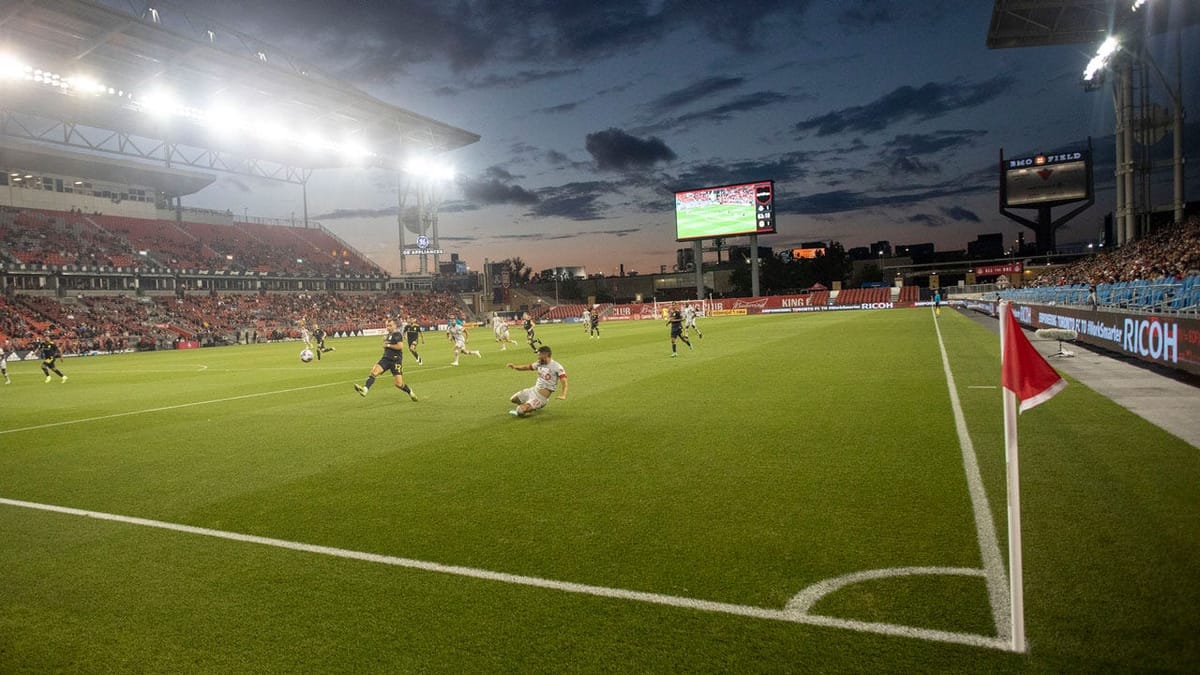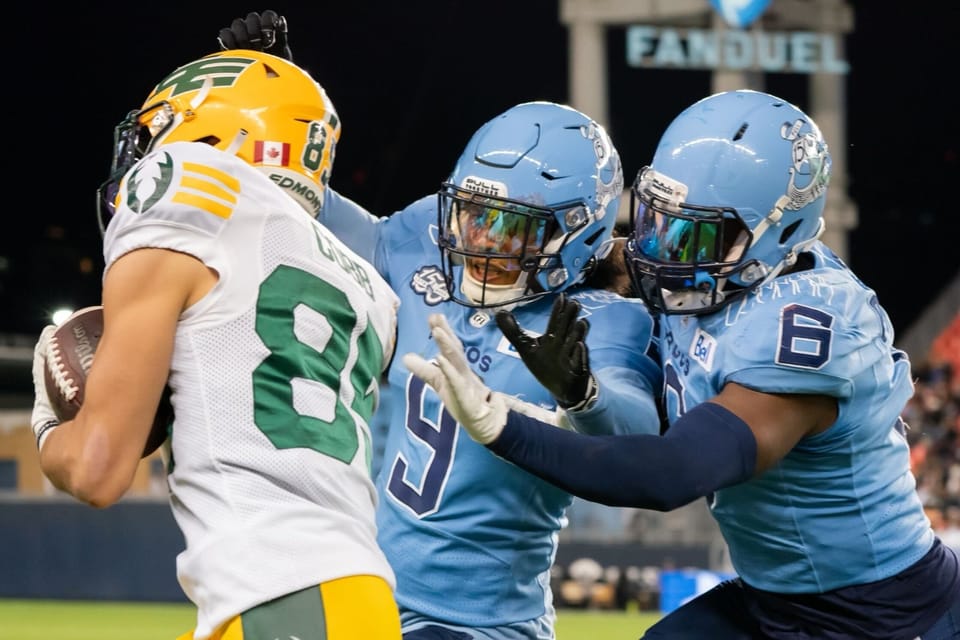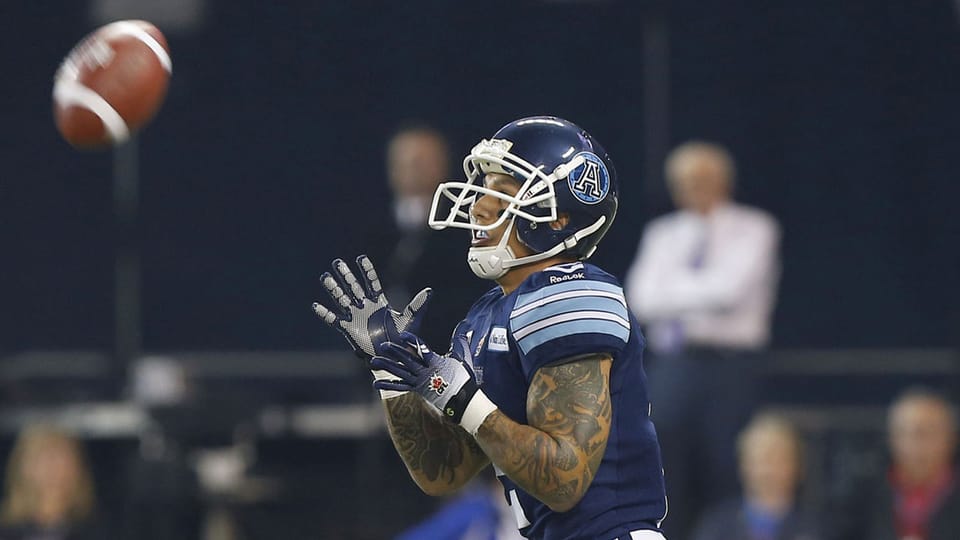Concerns about BMO Field pitch shouldn't be driving wedge between TFC and Argonauts supporters
Once again the playing surface at BMO Field has pinned Toronto FC supports and Toronto Argonauts fans in a battle on social media that seem to be missing the big picture.

It appears that it doesn’t take much to breathe new life into the feud between supporters Toronto FC and Toronto Argonauts.
Former Toronto mayor David Miller and former Maple Leafs Sports and Entertainment CEO Richard Peddie brought up their problems with TFC sharing the same pitch as the Argos.
Before I retired MLSE considered buying Argos I presented to Board 4 reasons why they shouldn’t One was that it was a natural turf soccer pitch & CFL football would destroy it.Today they are hurting a franchise worth more than $800m for one valued at maybe $10m
— Richard Peddie (@RichardAPeddie) 8:41 PM ∙ Sep 1, 2022
The Argonauts had just played two-straight games six days apart and their third contest in the month of August. TFC had just tied 2-2 against the LA Galaxy, their second game of the month and will play again Sunday evening against CF Montreal.
There didn’t appear to be any complaints from TFC players after the game about the playing surface or in the days after.
The Argos will not be playing at BMO Field until Oct. 8 against the B.C. Lions and then they end their regular season schedule against the Montreal Alouettes on Oct. 29 and could have one playoff game at home in November.
To no surprise, both Argos and TFC fans — including Miller who is a season ticket holder — got into a similar argument that we have seen in the past. It goes to show a missed opportunity from MLSE in many ways because it is a great venue that should be enjoyed by both fanbases.
How did the BMO Field pitch complaints even start?
In 2016 when the Argos made the move to BMO Field as TFC fans expressed their displeasure with the clubs having to share the stadium. What concerned the soccer fans was the impact playing CFL football would have on the pitch.
Many will remember when TFC star Sebastian Giovinco criticized the playing surface and the impact it had on his inability to finish games at the end of the 2016 season because of cramping. The Grey Cup was played not too long before the MLS Final and the groundcrew had to use sand to try and make the surface level.
“Maybe the only factor that may have contributed somehow in changing since last year is that now this year another team was playing in BMO Field,” he said through an interpreter at the time. “That may have contributed to changing something on the pitch.”
Earlier in the 2016 season, head coach Greg Vanney said he was pleased with the condition of the pitch after the Argonauts played their home opener and Canada took on Italy in a Rugby match in the same week.
Giovinco would take this further in 2018 when he called the playing surface amateur and believes it was leading to players suffering injuries.
The concerns raised by the Italian star were validated by Argos and TFC president Bill Manning who said the playing surface was not ideal for soccer which is fair considering the way a pitch can have an impact on the game.
However, to say the Argos are solely responsible for the condition of the pitch seems like a convenient argument. It is known that football does impact a grass playing surface but it’s not the only reason why the pitch isn’t in pristine condition.
Issues with BMO Field pitch predate Argos move
Anyone who knows the climate in Canada know how difficult it is to maintain a natural grass field. It is why many teams and outdoor stadiums in the country do not have an all-grass surface.
Back in 2014 after a match against D.C. United, the visiting club voiced their displeasure with the condition of the field. To be fair to Toronto, the game was played in the beginning of March but it didn’t stop Eddie Johnson from calling out the conditions.
“The field was crap,” Johnson said at the time. “Absolute crap. As much as that team is ambitious, with the acquisitions they’ve made, you feel like the field would be in much better shape than that.”
Even former TFC coach Ryan Nelsen told The Toronto Sun's Steve Buffery that the field conditions were tough to deal with.
"It's a major problem, a major leveler," said Nelsen, who compared the BMO Field grass to an ice hockey rink full of bumps, deep cracks and holes. "That evens it out for the other team."
The condition of BMO Field has been a talking point since TFC's home opener on March 22. It was poor then and, apparently, it's not much better now. Players and coaches were reluctant to use the pitch as an excuse for Saturday's 2-1 loss to the New England Revolution, but you could see the frustration simmering at the surface following the match.
"It's frustrating, because we want to play an attractive, attacking brand of football, and the field at the moment, it's probably not conducive to that unfortunately," said Nelsen. "In saying that, we still put together 530 passes on Saturday and that was more than any team in the whole league did, even on the better fields. It's the brand of football we want to be playing, and we want to be hard to beat, which is frustrating because we let in a couple of soft goals."
This was not the only time the field conditions were an issue before the Argonauts made the move. In 2015, CEO Tim Leiweke made it clear what is BMO Field’s biggest enemy.
"It's not the CFL that's the issue with the pitch, it's the winter," Leiweke said to The Canadian Press.
Groundskeepers battle Mother Nature as they prepare BMO Field for Toronto FC's home opener. Our story. #TFCLive bit.ly/3IAC0h3
— Neil Davidson (@NeilMDavidson) 9:42 PM ∙ Mar 3, 2022
In 2019, MLSE made its most significant investment in the playing surface bringing in the SISGrass system that is used at Lambeau Field and Wembley Stadium.
Head groundskeeper Robert Heggie made it known that the new field would give him more of a chance to avoid starting from scratch after the winter.
"It’s not easy being a groundskeeper," said Heggie. "But this will give me the peace of mind in January, February, December — those shoulder seasons when I just know it’s tough and we can’t get the root structure that we need."
TFC fans have every right to want a pristine surface for their players to play on as it will help prevent unneeded injuries and won’t have as much of an impact on how the ball bounces.
A few years ago, the NFL and NFLPA had to investigate the playing surface at MetLife Stadium because of multiple lower-body injuries. It was made known that playing on natural grass was a preferred option over turf based on research done.
We’ll see if the playing field becomes a concern in the final stretch of the season especially if TFC qualifies for the playoffs but for now, both fanbases shouldn’t get themselves worked up over Miller’s comments.

Read Toronto Sports Journal in the Substack appAvailable for iOS and AndroidGet the app
The real issue that is being ignored when it comes to stadiums in Toronto
If you read some of the responses to Miller’s initial tweet, the main argument was that numerous teams share the same stadium/facilities. There are some MLS and NFL teams that play in the same stadium, NYCFC have had to play their games at both Yankee Stadium and Citi Field.
So to say that Toronto FC should not have to share BMO Field is quite bizarre because many would argue that stadiums that only host one tenant isn’t something that is a sustainable business model. Many venues host multiple teams in the same stadium along with concerts and other events to help pay the bills.
When that point was brought up to Miller, he posted this tweet saying that when Skydome was built, it was for the Argos and Toronto Blue Jays which is true.
@jjasonf @GroovyJimmy Football, CFL or NFL is not compatible with a high quality soccer pitch. I’d be happy with a separate facility for the Argos - although the SkyDome was built for them so they’ve had a fair chance with public funding.
— David Miller T.O. (@iamdavidmiller) 2:42 AM ∙ Sep 30, 2021
Miller’s argument about the Argos having their own public funding for a stadium isn’t as cut as dry as he laid it out. Anyone who knows the complicated history of the dome would remember that it was a sinking cost to the Ontario government who invested around $570 million in the stadium.
They would sell SkyDome for $151 million to a private group which included Coca Cola, the Canadian Imperial Bank of Commerce and the Labatt brewing company who also owned the Blue Jays at the time. Eventually, Rogers would come in and buy SkyDome for $25 million.
"The purchase of SkyDome is an opportunity for us to acquire a tremendous asset at an extremely attractive price, but more importantly, we will now have significantly better control over our product and the fan experience," said Paul Godfrey, president and CEO of the Blue Jays said at the time.
Godfrey was not wrong because that decision to sell SkyDome would lead to the eventual plan for the Argos to have to go on a search for a new home. This was mainly because the Blue Jays wanted to put in a grass surface at Rogers Centre which would not be possible if they had to convert to a football layout.
At the end of their lease with the Argos, the Blue Jays would put in a permanent dirt infield but the dream of having grass remains an ongoing project.
Once the Argos were without a home, BMO Field was seen as the next best option and many pushed for the move to be made. The City of Toronto owns the stadium but MLSE operates the building and as part of the approval process for the renovations which included expanded capacity, accommodating CFL football was a part of it.
So for Miller to say that the Argos had their chance at SkyDome isn’t telling the full story and it speaks to the tough time the CFL franchise has had to get a true investment from past and current ownership.
They have a permit with the City of Toronto to use Lamport Stadium for practice, then the team goes back to BMO Field to use their locker rooms. Some players go to Coca-Cola Coliseum to conduct their workouts which they are fine with because it is within walking distance but it’s not like the facilities the other teams under MLSE have where everything is in one convenient location.
In the end, TFC fans should want their players to play on the best surface possible but in this case, this isn’t an Argos issue. Considering the discrepancy in investment between TFC and the Argonauts, the last thing the soccer club should be complaining about is that sharing a stadium is unfair and MLSE should be making it clear that having both teams at BMO Field isn’t an issue.
When it comes to the World Cup that’s scheduled to come to Toronto in 2026, that will be a different discussion, but that’s one for another day with the tournament four years away.



